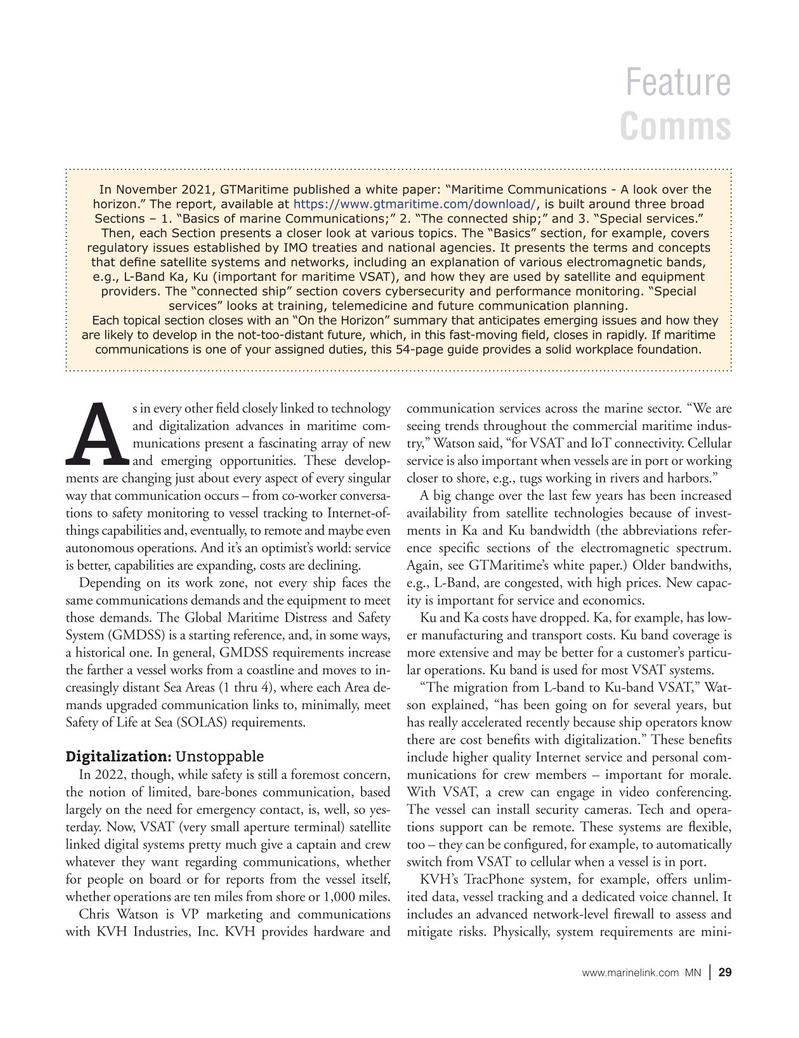
Page 29: of Marine News Magazine (June 2022)
Combat & Patrol Craft Annua
Read this page in Pdf, Flash or Html5 edition of June 2022 Marine News Magazine
Feature
Comms
In November 2021, GTMaritime published a white paper: “Maritime Communications - A look over the horizon.” The report, available at https://www.gtmaritime.com/download/, is built around three broad
Sections – 1. “Basics of marine Communications;” 2. “The connected ship;” and 3. “Special services.”
Then, each Section presents a closer look at various topics. The “Basics” section, for example, covers regulatory issues established by IMO treaties and national agencies. It presents the terms and concepts that de? ne satellite systems and networks, including an explanation of various electromagnetic bands, e.g., L-Band Ka, Ku (important for maritime VSAT), and how they are used by satellite and equipment providers. The “connected ship” section covers cybersecurity and performance monitoring. “Special services” looks at training, telemedicine and future communication planning.
Each topical section closes with an “On the Horizon” summary that anticipates emerging issues and how they are likely to develop in the not-too-distant future, which, in this fast-moving ? eld, closes in rapidly. If maritime communications is one of your assigned duties, this 54-page guide provides a solid workplace foundation.
s in every other ? eld closely linked to technology communication services across the marine sector. “We are and digitalization advances in maritime com- seeing trends throughout the commercial maritime indus- munications present a fascinating array of new try,” Watson said, “for VSAT and IoT connectivity. Cellular
A and emerging opportunities. These develop- service is also important when vessels are in port or working ments are changing just about every aspect of every singular closer to shore, e.g., tugs working in rivers and harbors.” way that communication occurs – from co-worker conversa- A big change over the last few years has been increased tions to safety monitoring to vessel tracking to Internet-of- availability from satellite technologies because of invest- things capabilities and, eventually, to remote and maybe even ments in Ka and Ku bandwidth (the abbreviations refer- autonomous operations. And it’s an optimist’s world: service ence speci? c sections of the electromagnetic spectrum. is better, capabilities are expanding, costs are declining. Again, see GTMaritime’s white paper.) Older bandwiths,
Depending on its work zone, not every ship faces the e.g., L-Band, are congested, with high prices. New capac- same communications demands and the equipment to meet ity is important for service and economics.
those demands. The Global Maritime Distress and Safety Ku and Ka costs have dropped. Ka, for example, has low-
System (GMDSS) is a starting reference, and, in some ways, er manufacturing and transport costs. Ku band coverage is a historical one. In general, GMDSS requirements increase more extensive and may be better for a customer’s particu- the farther a vessel works from a coastline and moves to in- lar operations. Ku band is used for most VSAT systems.
creasingly distant Sea Areas (1 thru 4), where each Area de- “The migration from L-band to Ku-band VSAT,” Wat- mands upgraded communication links to, minimally, meet son explained, “has been going on for several years, but
Safety of Life at Sea (SOLAS) requirements. has really accelerated recently because ship operators know there are cost bene? ts with digitalization.” These bene? ts
Digitalization: Unstoppable include higher quality Internet service and personal com-
In 2022, though, while safety is still a foremost concern, munications for crew members – important for morale. the notion of limited, bare-bones communication, based With VSAT, a crew can engage in video conferencing. largely on the need for emergency contact, is, well, so yes- The vessel can install security cameras. Tech and opera- terday. Now, VSAT (very small aperture terminal) satellite tions support can be remote. These systems are ? exible, linked digital systems pretty much give a captain and crew too – they can be con? gured, for example, to automatically whatever they want regarding communications, whether switch from VSAT to cellular when a vessel is in port.
for people on board or for reports from the vessel itself, KVH’s TracPhone system, for example, offers unlim- whether operations are ten miles from shore or 1,000 miles. ited data, vessel tracking and a dedicated voice channel. It
Chris Watson is VP marketing and communications includes an advanced network-level ? rewall to assess and with KVH Industries, Inc. KVH provides hardware and mitigate risks. Physically, system requirements are mini- www.marinelink.com MN | 29

 28
28

 30
30
